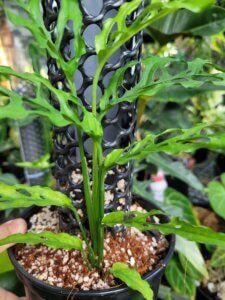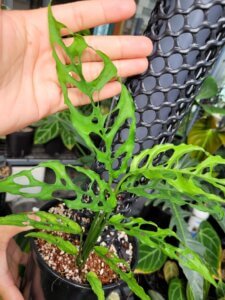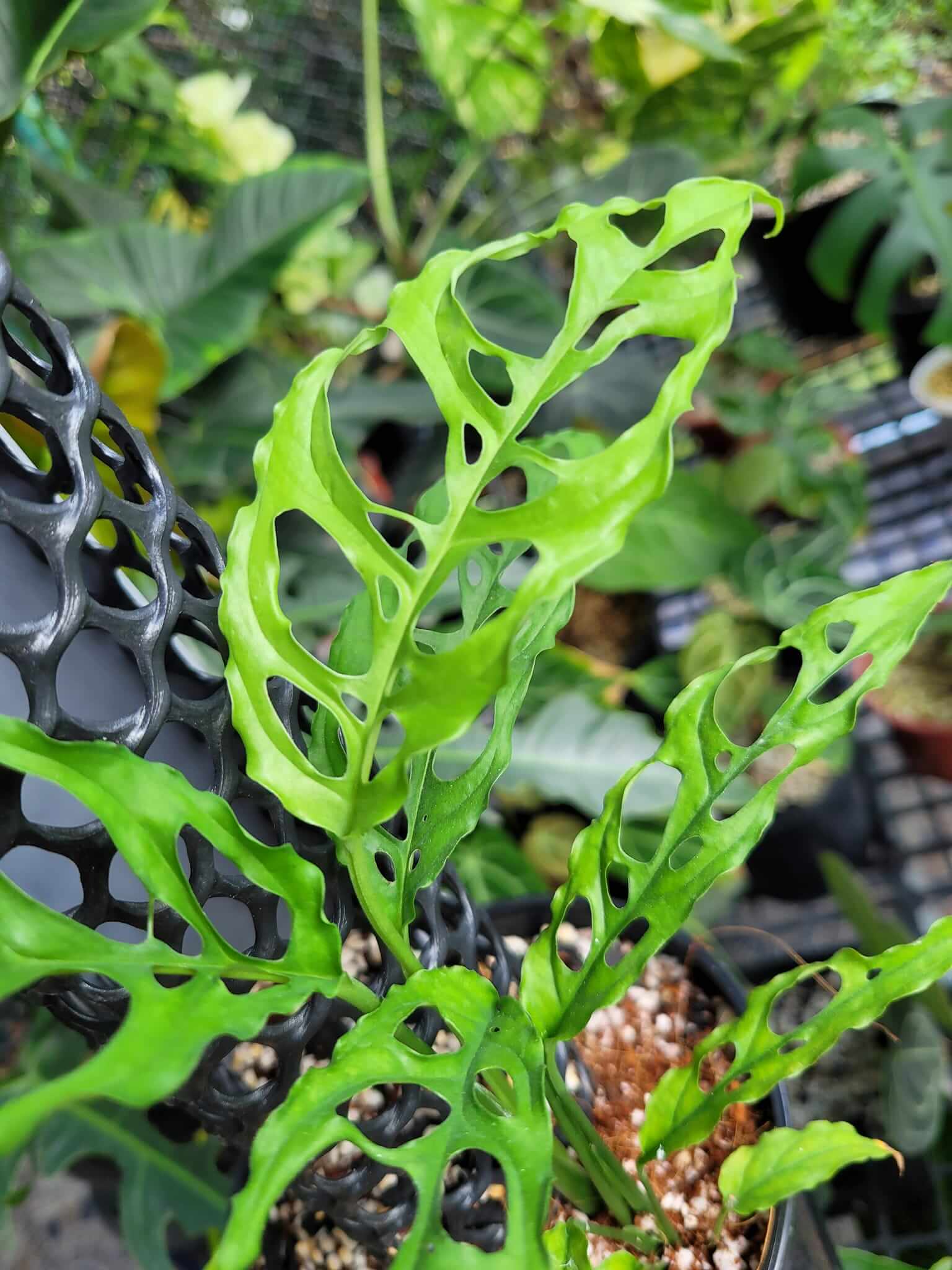Basic Information
Monstera Obliqua, often confused with its more common cousin, Monstera Adansonii, is a unique plant with specific needs. Unlike many houseplants, Obliqua’s thin, almost skeletal leaves make it alluring and delicate.



Light
Monstera Obliqua is a plant that requires bright to medium indirect sunlight for at least 7 hours daily. If the plant is exposed to direct sunlight, it may damage its delicate leaves. In case you don’t have enough natural light, grow lights are a good alternative. You should also keep in mind that if the plant is not getting enough light, you may notice its leaves turning yellow or wilting. Hence, keeping the plant in a well-lit room, such as a bathroom, is recommended to ensure its proper growth.
Water
The Monstera Obliqua plant has specific watering requirements that need to be taken care of delicately. It grows well when its soil is consistently moist, but avoiding overwatering and underwatering is crucial. To maintain a healthy balance, it is recommended to check the top inch of soil regularly for dryness before watering. Instead of following a strict watering schedule, it is best to evaluate the soil moisture regularly using your fingers or a moisture meter to determine when it’s time to water since the soil moisture will vary throughout the year. Additionally, it is essential to adjust the watering frequency seasonally and reduce it during the plant’s dormant periods in fall and winter.
Soil
The soil mix used for Monstera Obliqua can significantly impact its health. Using a nutrient-rich and well-draining aroid mix is recommended to avoid root damage. This is because Obliqua has a sensitive root system that can be easily damaged by heavy soil. You can add perlite and sphagnum moss to facilitate proper ventilation and moisture retention, essential to prevent root rot. The soil’s pH level should be slightly acidic, around 5, or neutral, around 7.5. A well-planned soil composition promotes healthy growth and development of the plant.
Temperature
Monstera Obliqua is a plant that prefers warm and humid climates, just like the tropical forests of South America where it originates. It thrives in temperatures between 70-85 degrees Fahrenheit (21-29°C), similar to its natural environment. If you plan to grow it indoors, it’s essential to replicate these conditions as closely as possible. Maintaining a stable and warm environment indoors is crucial, especially if you live in an area that is not naturally warm and humid.
Humidity
High humidity is required for the Obliqua plant to thrive, with levels above 80% necessary. You can achieve this by using a humidifier or placing the plant in naturally humid environments like bathrooms or kitchens. Grouping the plant with other plants can also help to increase humidity levels. Regular misting or using pebble-filled water trays can also help maintain appropriate humidity levels for the plant to grow and flourish.
Fertilizer
It is recommended to fertilize Monstera Obliqua plant less frequently than other Monstera species due to its slow growth rate. During spring and summer, fertilize the plant every two weeks to one month, but avoid fertilizing it during winter as it is a rest period for the plant. A balanced N-P-K fertilizer is ideal for the Obliqua plant, but be careful not to over-fertilize. Also, because of its slow growth rate, Obliqua plant requires gentle feeding, and heavy feeding is not necessary. During the growing season, apply a balanced, water-soluble fertilizer diluted to half strength once a month.
Growth Rate
One of the most challenging aspects of growing Obliqua is its slow growth rate. It takes several years for the plant to develop its whole leaf fenestration. Therefore, patience and consistent care are essential. Obliqua is one of the slowest-growing members of the Monstera family. The plant can take many years to grow and fully develop its characteristic leaves.
Pet Safety
Monstera Obliqua can be harmful if ingested by children or pets. Keep out of reach and monitor for accidental ingestion. In case of ingestion, immediately seek medical attention.
Grow in Semi-Hydro
- Monsteras, known for their robust growth and iconic split leaves, flourish in semi-hydroponics systems like LECA/Pon, thanks to their adaptive root systems and love for moisture.
- Transitioning Monstera to semi-hydroponics is effective with a Nutrient Stagnant Wicking (NSW) setup, ensuring a stable and efficient growth environment.
- In LECA/Pon, Monstera roots quickly adjust, overcoming any initial challenges with root adaptation in the NSW system.
- A nutrient mix with a concentration of about 800-1000ppm is ideal for fertilizing Monsteras in semi-hydro setups.
- Monsteras are adaptable to various temperature and humidity conditions, making them suitable for growth in diverse indoor environments.
- Ongoing care includes regular monitoring of the water level in the reservoir and periodic flushing of the system to promote healthy and continuous growth.
Tips
- Regular Misting: Keep the leaves dust-free and humid by misting them regularly.
- Support Structures: As your plant grows, provide support structures like moss poles to mimic its natural climbing habit.
- Watch for Pests: Check regularly for common pests like spider mites or mealybugs, especially under the leaves.
Growing Monstera Obliqua is not for the faint of heart. It demands attention, specific care, and a lot of patience. But for those willing to provide its needs, it’s a rewarding and stunning addition to any houseplant collection. Remember, each plant has its personality; part of the fun is learning and adapting to its unique requirements.
Happy planting! 🌱


